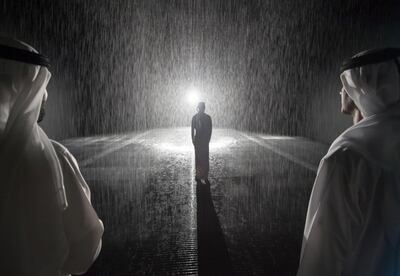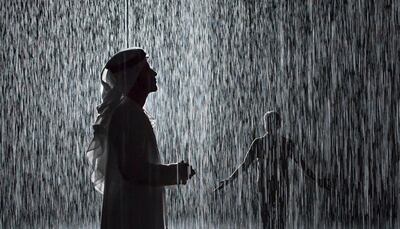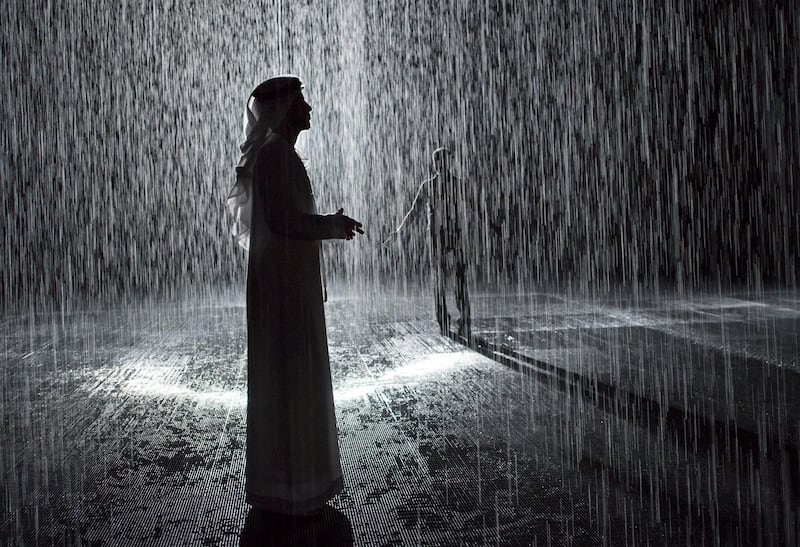Imagine, when you are hot and stifled by the prospect of endless sunny days with no rain, a room you could step into with gently falling water all around. And as you move through the room, you stay dry – not a drop touches you and your miraculously protected clothes.
It's not a fever dream of rain-starved expats. It is Sharjah Art Foundation's new permanent installation, Rain Room.
The artwork is the phenomenally successful immersive experience that has now come to Sharjah – in a bespoke building where rain gushes down and motion sensors detect bodily movement, so that as you move through the site, like Moses parting the Red Sea, the rain stops wherever you are.
The installation is made by Random International, a studio set up by two Royal College of Arts graduates in 2005, Florian Ortkrass and Hannes Koch. The pair, both German, are effusively friendly and enthusiastic about the way that Rain Room connects to a UAE context.
They generously take my first question – Rain? All the time? In Sharjah? – and explain that I am very much missing the point of the installation.
“There’s a slightly subtler layer that is more substantial,” Koch tells me gently.
Rain Room uses the spectacle of rainfall as an experiment in physical AI by allowing people to see and even feel the extent of automation and control that already governs so much of their lives.

"What's interesting here is putting Rain Room into an environment which is increasingly automated and regulated in terms of traffic and infrastructure," Koch says. "If you look at a place like Dubai Mall, where you have 80 million visitors in a year, there are whole agencies that collaborate with architectural bureaus to control people flow. How many people will be there, how many staff need to be at safety and security? The elevator system in the Burj Khalifa is fairly intelligent. I wouldn't say it is AI, but they are buildings that sense your presence."
Rain Room mimics this effect of a building that responds to one's presence by its sensors that perceive where you are. This is the first time the work has been installed in the Middle East. It opened first at the Barbican Centre in London in 2012, then travelled to the Museum of Modern Art in New York, the Los Angeles County Museum of Art, and the Yuz Museum in Shanghai. In Los Angeles, it opened eight months into a major drought, and coverage there was also dominated by the spectacle of falling rain in an environment starved of water. Similar concerns are relevant here, although the water is purified and reused in the installation, meaning that the actual usage is quite low.
The Sharjah Art Foundation's building is roomier than the others. Because Rain Room exists as an editioned artwork, the area of rainfall remains the same in each iteration, but Sharjah's has given more space around it. The architect also designed a ramp down towards the installation itself, which Koch likens to entering "a cathedral for the rain".
The pair have also taken note of the audience's reactions to Rain Room so far, which has fed back into their practice that investigates questions of human response to automation, such as the way people ascribe feelings and characteristics to inanimate intelligent objects.
"We did a project in the Roundhouse in London with seven spheres where they would warm to each other," says Ortkrass, about their work in +/- Human. "They didn't have very outspoken behaviour, but people would project on to them – one was the scary one, one was afraid, one was friendly. Your brain creates this whole narrative of alive objects."
The reactions to Rain Room show how people tend to interpret situations in which they have no control with the opposite – delusions of control.
"There is a need for cognitive dissonance in Rain Room," says Koch. "We found that the Barbican Centre, without having seen it, was advertising it like 'How would it feel to be in control of the rain?' But it's far from that. Your pace and the way you move, even your posture, is controlled by the machine, in the way that this machine feeds you through itself. There's this illusion of being in control and being on top of the behavioural food chain, and the facts are fairly different."

"It was really interesting to hear the comments on the imperfections of Rain Room," he continues, noting that people loved to point out when Rain Room appeared to malfunction and let slip a drop of water on their heads. "That is a really typical natural thing with machines. When algorithms become physical, you encounter all their physical messiness and their imperfections."
Indeed Rain Room has become memorable not for its algorithm, but for all the joyous human encounters that have gone on within: children outrunning the sensors; selfies being taken; even couples getting engaged. And that's been in countries used to rain. Imagine what will happen here.
Rain Room is at the Sharjah Art Foundation, in the Heart of Sharjah. Visits can be booked in advance or purchased at the door and are Dh25 for adults, Dh15 for teachers and students up to the age of 22, and free for children under five.Saturday–Thursday: 9am to 9pm, Friday: 4pm to 11pm
___________________
Read more:
[ Are visitors to malls and Dubai buildings controlled by algorithms? ]
[ Global Art Forum: What does artificial intelligence look like? ]
[ How resistance has emerged as a trend in the UAE art scene ]
___________________






